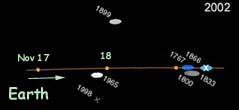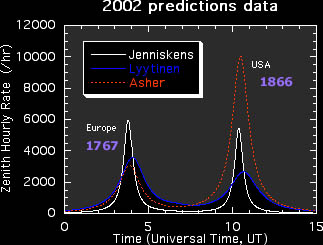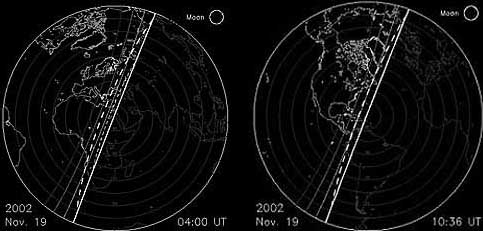Pedictions of Leonid
activity, peak time, and viewing conditions.

|
DUST TRAILS
In 2002, Earth will travel through the dust ejected in 1767 (visible from Europe)
and 1866 (visible from the Americas). This picture shows the dust trails of
comet 55P/Tempel-Tuttle relative to Earth orbit in
November 2002.
|

METEOR ACTIVITY
Graph above shows the expected variation of Leonid meteor activity (in
numbers per hour under ideal observing conditions). Two Leonid storms are
expected with rates higher than in 2001, when the Zenith Hourly Rate
peaked at 1,300 /hr for the USA peak. Beware: the next Leonid storms are
not due until 2099!
OBSERVING LOCATIONS
View of Earth from the perspective of the incoming Leonids at the peak of each storm. The circles show the height of the shower radiant, while the vertical lines are various phases of twilight. The storms are best seen on the left night-time side of each
graph. Spain, for example, has perfect viewing conditions for the 04:00 UT
storm, while the USA has excellent viewing of the 10:36 UT storm.

Earth from the perspective of the meteor shower at the peak of each 2002 Leonid storm. Image courtesy of Robert McNaught, Astronomical Society of Australia.
SUMMARY LEONID FORECASTS FOR NOVEMBER 19, 2002 UT *)
|
Dust ejected in: |
Best seen: |
Asher/McNaught
(1999) |
Lyytinen
(1999, update 2002) |
Jenniskens
(2001, update 2002) |
Vaubaillon
(2002) |
1767 |
Western Europe |
03:53 UT
ZHR = 3,000 /hr
FWHM =1.5 hr |
04:03 UT
3,500
1.76 hr |
03:48 UT
5,900
0.64 hr |
04:04 UT
3,600
|
1799 |
Western Europe/
Americas |
-.- |
-.- |
04:50
51
4.1 hr |
-.- |
1833 |
Americas |
-.- |
06:36 UT
160
|
05:59
28
4.8 hr |
-.- |
1866 |
Americas |
10:29 UT
10,000
1.2 hr |
10:40 UT
2,600
2.03 hr |
10:23 UT
5,400
0.60 hr |
10:47 UT
3,200
|
|
*) On November 17, at 20:10 UT (Asher) or 19:30 UT ( Jenniskens), Earth
will pass the 1965 dust trail at considerable distance. Predicted peak rates
are less than ZHR = 1, but east Asian observers should be on alert for a
possible minor outburst that night.
WHY DO PREDICTIONS DIFFER?
Asher & McNaught assume mild ejection from
comet at perihelion in forward direction of motion - following Reznikov & Kondrat'eva.
Lyytinen assumes release at perihelion (no ejection), but continued broadening and
acceleration at perihelion due to
radiation pressure effects. Vaubaillon has built a theoretical model based on numerous
dynamically diverse meteoroids.
Jenniskens derived trail positions from recent Leonid MAC
observations and finds systematic shifts (ejection towards the Sun), and
no significant broadening of showers over time.
LEONID STORM OBSERVING GUIDES
Amateur astronomers interested in helping to monitor
the Leonid shower could
make an effort to collect counts of Leonid meteors in 1-minute intervals. It
takes the shower about 2 minutes to cross the United States from the East
Coast to the West Coast. With precise enough data, we can see the shower
sweep accross the country and recognize filamentary structure, if there is any.
Here
is an electronic form to report such flux measurements.
Help with pointing your instruments is given in this
introduction paper by Peter Jenniskens.
A lot more background information on where to point instruments on the sky
during a Leonid encounter can be found in the final chapters of the paper
"Leonid Storm Flux Analysis
from one Leonid MAC Video AL50R" by P. Gural and P. Jenniskens (Download here).
EXTERNAL LINKS TO SIMILAR TOPICS:
(<<)
|
|




